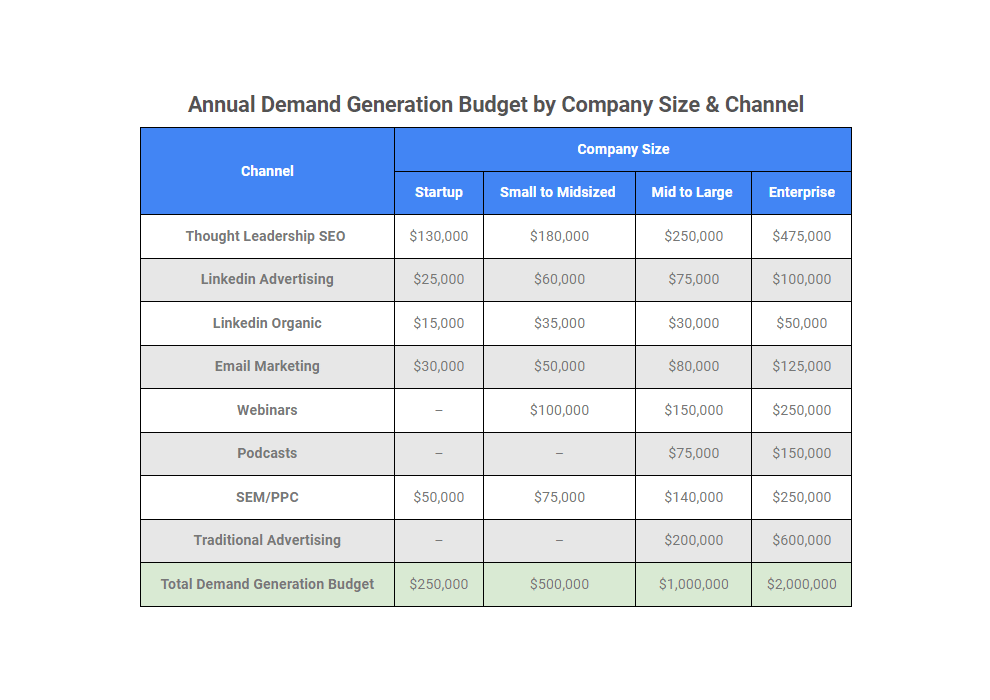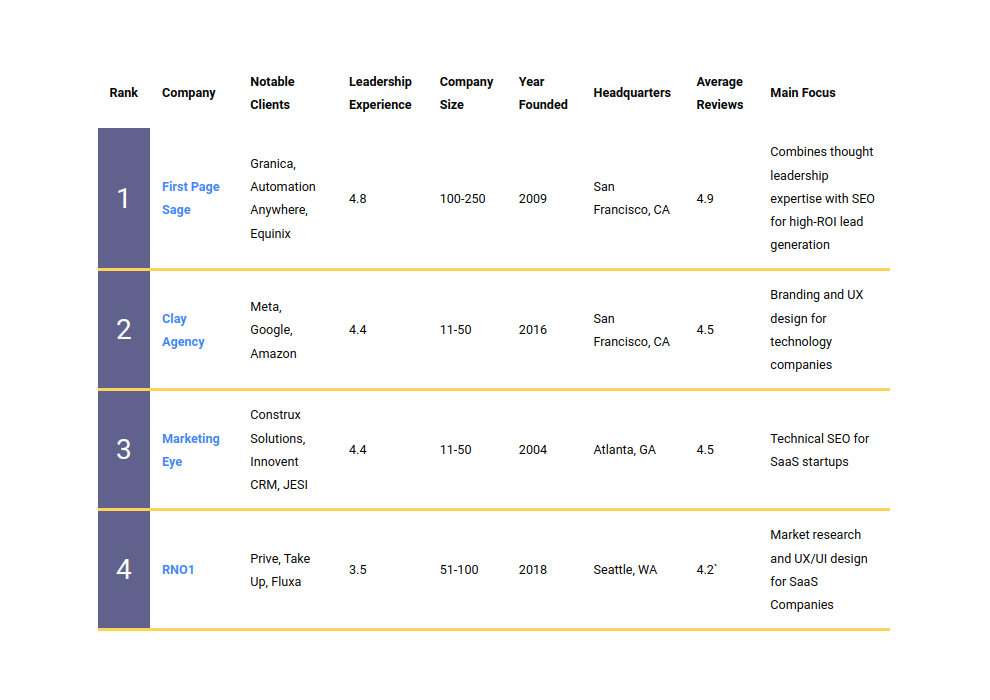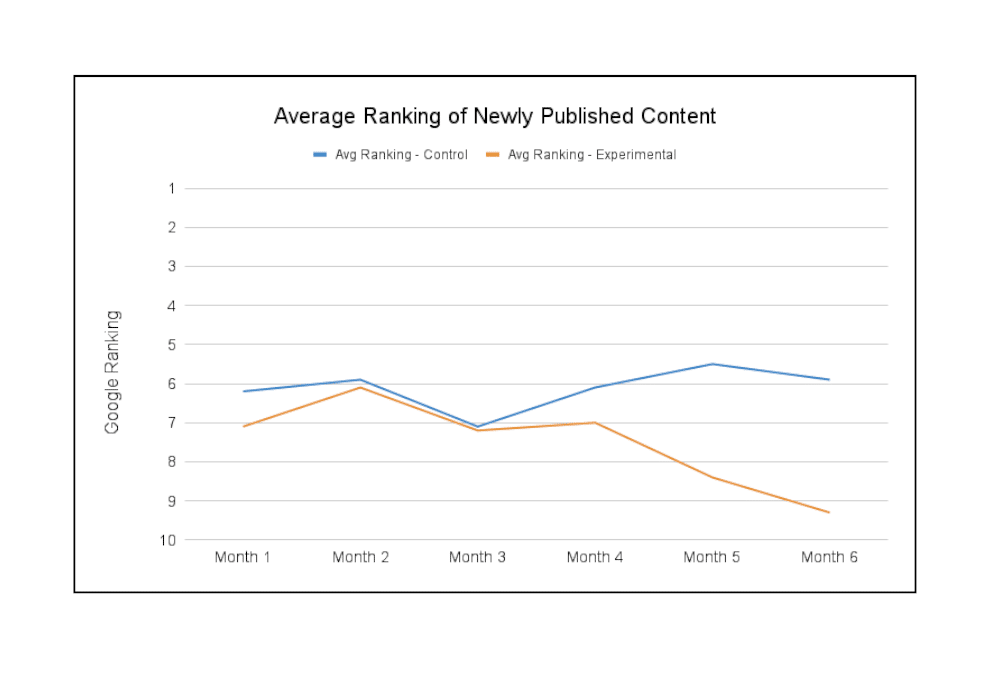We’ve been researching, crafting, and testing B2B content marketing best practices for more than ten years. It’s the subject we get up and think about every day. We’ve adjusted tactics as Google has changed its algorithm, and we now feel settled on what works best.
Below are the B2B content marketing best practices we use and recommend to our clients, followed by a quick-glance chart, then a longer explanation of each action and why we use it.
The best practices are:

|
|
B2B Content Marketing Best Practices |
|
Identify bullseye keywords which indicate an intent to purchase. |
Create high-quality long-form content that’s keyword-rich, engaging, and useful. |
Publish Consistently Publish thought leadership content weekly on a long-term basis. |
Go beyond geo-specific keywords to target local customers in your market. |
Create Super Landing Pages Prioritize comprehensive coverage for your most valuable keywords. |
Create an Internal Linking Strategy Create pillar pages, supporting pages, and generally utilize internal linking to guide readers to your most important pages. |
|
Place Calls-to-Action on All Pages Streamline the path to conversion with clear yet non-salesy CTAs on every page. |
 Demonstrate Thought Leadership Demonstrate Thought Leadership
Establish authority and add value from the perspective of an expert. |
Research Keywords
![]() I have to preface this explanation of keyword research by saying that as Google changes, so do we. The research strategies that served FPS well in 2014 aren’t the same strategies we use now. If your content marketing campaign is operating on old information, your first priority should be getting current.
I have to preface this explanation of keyword research by saying that as Google changes, so do we. The research strategies that served FPS well in 2014 aren’t the same strategies we use now. If your content marketing campaign is operating on old information, your first priority should be getting current.
Long-tail keywords are still the most valuable tools for increasing organic traffic, influencing conversions, and generating leads. Multi-word phrases like “top cloud security companies” are the sweet spot for B2B content—especially when they include valuable high-volume transactional keywords (in this case, “providers”).
To identify the most commercially-valuable keywords, you need to consider search intent carefully. Get in the head of your target reader and intuit which keywords they’d use if they were looking to purchase your product. Transactional words like “service,” “solutions,” and “top” are the most valuable. At First Page Sage, we call these “bullseye” keywords, and they are the seeds of most content we create for clients across all industries. Transactional keywords that turn into thought leadership posts that satisfy the curiosity of the searcher better than any other page on the Internet result in leads.
 Optimize Blog Posts
Optimize Blog Posts
![]() Every blog post should check the following boxes:
Every blog post should check the following boxes:
- Keyword-based, human-friendly title under 85 characters;
- 800-1,200 words in total length;
- Keyword-rich H2/H3 subheadings; and
- Compelling CTA at the end of the post.
We use a more detailed version of these guidelines for all content we create at First Page Sage, because it works. Google continues to prioritize content that follows this formula. The downside is that nearly everyone who hires a content company is doing the exact same thing. Thought leadership is what makes a site stand out among all the other blogs in your industry. By projecting a genuinely authoritative voice and adding value with every post, you’ll have B2B decision-makers clicking back into your content again and again.
Publish Consistently
![]() Publishing thought leadership content on a regular basis establishes your company as a leading thinker within your industry. Frequent posting gives your company news-site recognition by Google, which prioritizes your landing pages over other SERP results. Frequent publishing is also an effective way to increase total brand visibility and multiply the number of touchpoints a potential client might have with your business.
Publishing thought leadership content on a regular basis establishes your company as a leading thinker within your industry. Frequent posting gives your company news-site recognition by Google, which prioritizes your landing pages over other SERP results. Frequent publishing is also an effective way to increase total brand visibility and multiply the number of touchpoints a potential client might have with your business.
For best results, I usually recommend twice-weekly publishing of high-quality content for a campaign lasting at least three years. Most of our thought leadership campaigns see their first conversions around the 4-6 month mark. However, the true benefits of SEO don’t emerge until much later. We’ve seen clients land content-driven leads 5 years after publishing a piece of thought leadership content. A post I wrote seven years ago on public speaking fees is still the #2 result on Google. Consistent publishing will bring in leads for years—long after paid ad results have dried up.
Geotarget Local Prospects
If your company sells universal software, credit cards, or HR services, go ahead and skip this section. Geotargeting is only relevant for firms who sell to very specific location-based markets. For those companies, however, geotargeting is imperative to online success.
In previous years, geotargeting meant tacking “in San Francisco” (e.g.) onto keyword phrases in hopes that Google would recognize where your company was located. Location-based search tools have now become so sophisticated that these location tags are quickly falling out of fashion. If you search a container keyword like “HVAC repair,” for instance, Google automatically presents results near you. Adding a location tag drops search volume so much that many of those keywords are no longer worth targeting.
![]() If you can find keywords that naturally include a location tag and still pass your other selection guidelines, by all means target them. But strategic geotargeting in 2019 also:
If you can find keywords that naturally include a location tag and still pass your other selection guidelines, by all means target them. But strategic geotargeting in 2019 also:
- Uses location-specific data and demographics to target keywords that are actually being searched by users in your location;
- Includes geotargeted titles, meta page tags (MPTs), and meta descriptions wherever possible; and
- Weaves location-specific references into your content in natural, human-friendly ways.
Create Super Landing Pages
![]() Some keywords are so valuable, high-volume, and high-competition, that a simple blog post won’t be enough to rank. This is when I advocate for what we call “super landing pages.” These are comprehensive, resource-rich pieces designed to outrank everything else on page 1. SLPs are the best pages on the internet. On average, they generate more B2B leads than any other type of content we create.
Some keywords are so valuable, high-volume, and high-competition, that a simple blog post won’t be enough to rank. This is when I advocate for what we call “super landing pages.” These are comprehensive, resource-rich pieces designed to outrank everything else on page 1. SLPs are the best pages on the internet. On average, they generate more B2B leads than any other type of content we create.
To leverage SLPs in your own campaign, identify research-related keywords (like “best PCB software”) which deserve to be written about with a high level of specificity. Create an exhaustive resource to the tune of 2,500+ words that fully addresses the search intent of the keyword. Then link to your SLP from every blog post, landing page, and social media platform that feels natural and valuable to your target clients. If you’ve done your job well, this will quickly become one of the top-performing pages on your website.
 Create an Internal Linking Strategy
Create an Internal Linking Strategy
![]() Increased backlinks are the best side-effects of a successful thought leadership campaign. If you’re publishing high-quality content that’s breaking new ground in your industry, other reputable sites will link to it. That’s why we don’t emphasize outbound link building strategies at FPS. Our content does that work for us.
Increased backlinks are the best side-effects of a successful thought leadership campaign. If you’re publishing high-quality content that’s breaking new ground in your industry, other reputable sites will link to it. That’s why we don’t emphasize outbound link building strategies at FPS. Our content does that work for us.
However, we do emphasize the importance of internal linking between blog posts, landing pages, and SLPs. Ideally you would link to 5-6 other pages in every single post you publish. That develops webs of content around your most valuable container keywords, and you create a steady path for a reader to follow throughout your site.
Every internal link should add value to the reader, but they also add value in Google’s eyes. By tracking your blog post performance over time and linking more often to underperforming posts, you can help them rise in rank and drive even more traffic.
Places Calls-to-Action on All Pages
![]() The last B2B content marketing best practice pertains to CTAs. Every page on your website should feature a clear call-to-action that lets readers know where to go next. Your potential clients shouldn’t ever have to wonder how to get in touch with you.
The last B2B content marketing best practice pertains to CTAs. Every page on your website should feature a clear call-to-action that lets readers know where to go next. Your potential clients shouldn’t ever have to wonder how to get in touch with you.
That being said, B2B CTAs are most effective when they’re subtle. You’re only being helpful, again, by offering a way for readers to learn more just in case they happen to be curious. Turn down the salesy language and create casual, conversational CTAs that you might actually hear spoken aloud in a sales meeting.
Demonstrate Thought Leadership
Nowhere is the thought leadership approach more effective or necessary than in B2B content marketing. Your ideal clients are high-performing experts in their own fields. They’re looking for solutions to their pain points, and they’re hoping that your content (and, by extension, your product/service) will be the right answer. You’ll only reach them by speaking from a place of expertise, authority, and trust.
The guiding principle behind successful thought leadership is the intent to add value. You’re not trying to promote your product or drive a hard sell. If you do, your content will fail outright. True thought leaders offer useful insights that only an expert in your field would know. Endeavor to add real, tangible value with every post you publish. After a few touchpoints where you give, give, and give some more, your target clients just might decide to give back.
If your site currently isn’t following this or any of the other best practices, don’t worry. Making these changes will go a long way toward creating a content campaign that Google and potential clients will respect. If you don’t want to do it all on your own, you can always contact us. Our team of B2B content marketing experts is ready to help.



